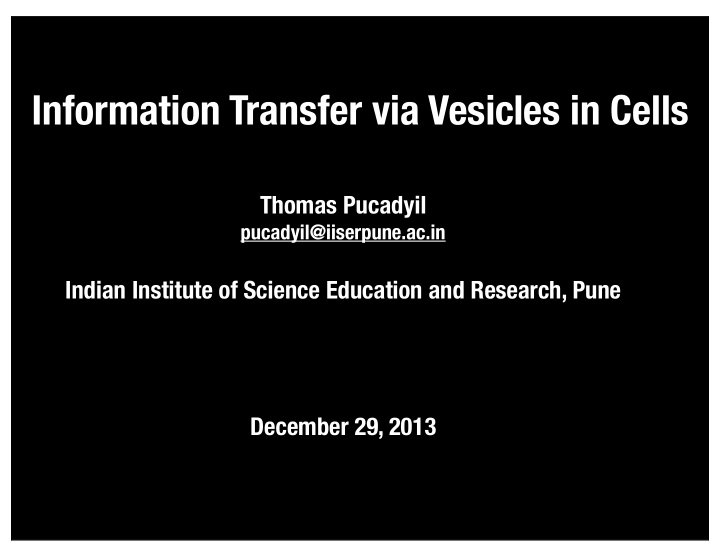



Information Transfer via Vesicles in Cells Thomas Pucadyil pucadyil@iiserpune.ac.in Indian Institute of Science Education and Research, Pune December 29, 2013
How do we perceive any sensation ? Information is transferred by electrical signals within neurons and by chemical signals across neurons
The Brain A vast (~a billion) collection of neurons interconnected and communicating with each other via chemical signals
The Synapse A physical barrier for interneuronal communication Signals across neurons are transferred via vesicles filled with neurotransmitters Neuron 1 called synaptic vesicles Synapse Neuron 2
Length Scales Relevant to Biology
Schematic of a Synaptic Bouton - the tip of a neuron Chemical signals are generated in the form of neurotransmitter filled synaptic vesicles which fuse with the cell boundary to release neurotransmitters by a process called ‘exocytosis’ and are regenerated by a process called ‘endocytosis’ A Synaptic Vesicle 50 nanometers
Formation of Synaptic Vesicles Birth of synaptic vesicles relies on a process called clathrin-mediated endocytosis
Clathrin-mediated Endocytosis Clathrin is a protein that has a tendency to come together to form a polyhedral structure This coming together leads to growth of a scaffold that contributes to budding of vesicles from the cell boundary
Budding and Fission of Clathrin-coated Pits Clathrin-mediated endocytosis is a highly conserved process that in the brain is specialized to generate synaptic vesicles In other cells, the same process contributes to nutrient uptake and regulation of cell surface display of receptors Clathrin self-assembly generated a shallow pit Further self-assembly generated a deeper membrane bud Deeply invaginated buds are release by a process of membrane fission
We Study Budding and Fission of Clathrin-coated Pits 12/29/13 Welcome Welcome Research Members Papers Courses Resources pucadyil lab Thomas Pucadyil Understanding cellular processes by reconstitution Manish Kushwah The watchmaker’s paradigm ____________________ Anyone who’s owned a watch would agree that this little machine is a marvelous creation. Some may admire it as it ticks undisturbed in its protective casing. But like the watchmaker, those curious to know how it functions so precisely to maintain time are taken by an irresistible desire to open the back cover and dismantle the many small gears and Srishti Dar springs. When put back together and the watch ticks as before, the 'watchmaker kinds' are overcome by a sense of gratification and humility in having finally understood how this little machine works. Cells are like watches and molecules inside them are the gears and springs that have evolved to coordinate and Devika Andhare catalyze reactions necessary for growth and survival of cells. But unlike watches, we don't quite know which molecules function as gears or springs. Moreover, experimental intervention to understand a single process in a complex machine like the cell can very often be confounded by global effects on cell growth and survival - akin to how the watch would stop working if any one of its many gears or springs are tampered. Cells transport soluble and membrane proteins across organelles in membrane bound vesicles - a process that is termed vesicular transport. This process is necessary to generate cellular organelles and maintain their identity throughout the lifespan of the cell. When applied to cellular processes, the watchmaker’s paradigm of learning by Sachin Holkar putting pieces back together to recreate function is termed biochemical reconstitution. We utilize this approach to understand the mechanism of vesicular transport and our efforts are guided by inputs from observing this process in Raunaq Deo living cells and rational design principles. Sukrut Kamerkar www.iiserpune.ac.in/~pucadyil/Welcome.html 1/2
Recommend
More recommend